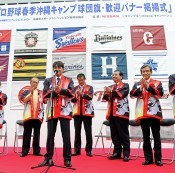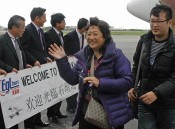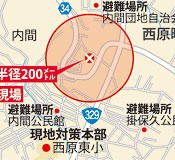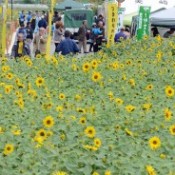Top News
January 26, 2012 Hideki Matsudo of Ryukyu Shimpo reports from Washington D.C.
In the afternoon on January 24, veteran Democratic Congressman Barney Frank, who is an influential politician within the U.S. government, met with members of the “Making Okinawan Voices Heard in America” delegation, including delegation leader Tokushin Yamauchi, a member of the House of Councilors of Japan. Frank said that he thinks that the presence of the U.S. Marine Corps in Okinawa is a hangover from World War II and that there is no longer any need to station them there. When interviewed by the Ryukyu Shimpo, Frank stated that he would also say this to President Barack Obama. He intends to call for the U.S. government and the Congress to consider withdrawing the Marines from Okinawa.
In the media, Frank has stated that removing the Marine Corps from Okinawa is one way that the U.S. government could reduce its budget deficit.
To Yamauchi, who opposes the relocation of Futenma Air Station to Henoko and the Kadena-Futenma integration plan, Frank said that he questions the need to station Marines in Okinawa because World War II ended 67 years ago, and asserts that the U.S. Marines should leave Okinawa. With regard to the U.S. military presence in Okinawa serving as a deterrent, which both the U.S. and Japanese governments claim is the main reason why the Marines are needed in Okinawa, Frank suggested that air and naval forces could deal with any threat from China and said that there is no possibility that Marines would ever be sent to fight on the Chinese mainland.
(English translation by T&CT, Mark Ealey)
Go To Japanese

January 25, 2012 Ryukyu Shimpo
On January 24, a welcome ceremony for professional baseball spring training camps in Okinawa was held in the plaza in front of the Prefectural Government Office in Naha. Organized by the Okinawan Prefectural Government, the Okinawa Convention and Visitors Bureau (OCVB), and the Okinawa Sports Convention Promotion Association, it featured an array of flags representing the ten Japanese and five Korean baseball clubs that will hold camps in Okinawa. The organizers made their expectations clear saying, “Let’s offer a good welcome as hosts and hope that this helps to promote tourism.”
Nine Japanese clubs, including the Chunichi Dragons, Hanshin Tigers, Hokkaido Nippon-Ham Fighters, and the Tohoku Rakuten Golden Eagles commence camps from February 1, and the Yomiuri Giants start from February 19. With regard to the Korean clubs, the LG Twins start from February 16 and four other clubs will follow on from mid-February.
About 200 people from the various hosting communities and those involved in tourism participated in the ceremony. Governor Hirokazu Nakaima gave a speech in which he said, “Many fans come from all over the country to watch the training camps. I hope that you all support the camps.” Invited guest Hiromichi Ishige, former manager of Orix Bluewave said, “The season for spring training camps starts in Okinawa. They play an important role for clubs and players. Please come to the stadiums and spend some quality time there with your families.”
President of the OCVB Shigenobu Asato said, “Let’s offer a sincere thank you and welcome the clubs and players” and then closed the ceremony with a traditional single clap.
Banners will be placed around Naha Airport and Kokusai Street until end of February to welcome those on the camps and to broadcast their presence to residents and tourists.
(English translation by T&CT, Shinako Oyakawa and Mark Ealey)
Go To Japanese

January 26, 2011 Ryukyu Shimpo
On January 25, Xiamen Airlines provided its first charter flight to Naha from Fuzhou in China’s Fujian Province. This is also the first time that a general group of travelers has come on a direct flight from Fuzhou. At the international terminal in Naha Airport, representatives from Naha City and the Okinawa Convention & Visitors Bureau held up a welcome banner before presenting commemorative gifts and bouquet flowers to the 126 passengers.
The success of the visit to Fuzhou last November to commemorate the 30th anniversary of the formal establishment of friendly relations between the two cities by representatives of Naha and people involved with the prefecture’s economy led to this first group tour happening.
A group member visiting Okinawa for the first time with his wife said, “Okinawa and Fuzhou have well established friendly relations. I hope that I can contribute to that relationship with this trip.”
With Xiamen Airlines providing this first charter flight to Okinawa, the person in charge in a travel company in Okinawa said, “I hope that this charter flight leads to the commencement of a regular service.”
(English translation by T&CT, Lima Tokumori and Mark Ealey)
Go To Japanese

January 22, 2011 Ryukyu Shimpo
On January 21, the first direct charter flight between Hong Kong and Ishigaki arrived at Ishigaki Airport. After the flight landed, Ishigaki City and the Ishigaki City Tourist Association welcomed the tourists in true Yaeyama style with gifts such as star sand, the exoskeleton of foraminifers – marine protozoa that once lived on the ocean floor, and a performance of a lion dance.
A leading travel company based in Hong Kong, EGL Tours, planned the charter flight and Japan Transocean Air provided the service. One hundred twenty tourists participated and the aircraft was full. They plan to visit Ishigaki and the main island of Okinawa for a total of three nights and four days.
The tourists enjoyed taking photographs and videos of the ceremony.
(English translation by T&CT, Lima Tokumori and Mark Ealey)
Go To Japanese

January 24, 2012 Ryukyu Shimpo
On January 23, a New Year’s prayer was carried out at Higa Katsuren in Uruma City. The prayer is called Hachiugan and people went around 12 sanctuaries praying for the prosperity of the island and for their family’s health. About fifty residents, from young to old, men and women, gathered to exchange New Year’s greetings saying, “Iisoguwachi debiru (“Happy New Year” in the Okinawan language) at the fifth sanctuary, called Shirumichuu.
The sanctuary is known as the home of the gods Amamikiyo and Shirumikyo, who created the Ryukyus. For Hachiugan, women priests and residents offered prayers and performed songs and dances. Students of Higa Elementary School and Higa Junior High School also joined in the prayer.
Seventy-eight year-old resident Setsuko Heshiki said, “The site soothes our souls. I prayed for the health and safety of my family.” Isamu Heshiki the ward chief of Higa said, “Every time I come here it clears up, even at times of bad weather, so I can sense divine power. I would like to continue this important tradition with children living on the island.”
(English translation by T&CT, Shinako Oyakawa and Mark Ealey)
Go To Japanese

Go To Video
January 24, 2012 Ryukyu Shimpo
From early February to late March, in the areas around U.S. Marine Corps Air Station Futenma, the Ginowan City Office will carry out a general investigation of poor reception of digital terrestrial broadcasts due to interference caused by U.S. flight activities. Although residents can normally watch and listen to their televisions and radios without any problems, when a plane flies nearby, noise or blackness on the screen affects their reception. This survey will be carried out primarily in order to obtain more information about the negative impact on life in all areas of the city. Under the Law concerning the Improvement of the Living Environment around Defense Facilities, the municipal office will receive 4.9 million yen from the Ministry of Defense for the survey and will commission specialized companies to do the work.
The Okinawa Office of Telecommunications surveyed the situation using instruments installed at nine points in the city over a period of 60 days from June 10, 2010, including community centers, and confirmed interference caused by U.S. aircraft in five locations.
According to survey results in the previous year from the Okinawa Defense Bureau, they also confirmed that interference occurred for about 2000 households, or about 900 buildings, located in part of areas of three districts north of the airfield runway, including Nodake, Futenma and Aragusuku.
In these areas, the city office has taken measures to set up cable television fully subsidized by the Ministry of Defense. However, it decided to carry out the survey once again because it received many complaints from residents outside the areas.
(English translation by T&CT, Mark Ealey)
Go To Japanese

January 24, 2011 Ryukyu Shimpo
Many tourists from China and Taiwan, where it is now the long Chinese New Year holiday, are coming to Okinawa. They are mainly from Beijing, Shanghai, Hong Kong and Taiwan and a spokesperson for the Okinawa Convention & Visitors Bureau (OCVB) said, “The number of tourists must be growing because there are more charter flights than last year.”
During the week around this holiday season, China Airlines (Taiwan) increased its one 300-passenger charter flights from last year to three flights.
According to staff of the Okinawa branch of Hong Kong Airlines (HKA), from last year the number of tourists has grown by 10 percent because of the increase in the number of direct flights, such as the new Hainan Airlines (the parent company of HKA) service between Naha and Beijing, and the introduction of larger aircraft by Hong Kong Express Airways.
Meanwhile, tourism industry officials have enhanced the support systems for receiving inbound tourists. Between January 21 and 29, the OCVB will distribute 7500 free monorail one-day passes to tourists and by January 23, they had already given out 1600.
About 1500 guests will stay at the Pacific Hotel Okinawa in Naha during the holiday week. To create a welcoming atmosphere, they have prepared decorations and music for Chinese New Year and for breakfast offer Chinese boiled-dumplings, which are believed to be lucky if you eat them at New Year.
On January 23, a tourist from Taiwan said, “I’m looking forward to going shopping. I will spend all of what I have brought with me for shopping.”
(English translation by T&CT, Lima Tokumori and Mark Ealey)
Go To Japanese

January 23, 2012 Ryukyu Shimpo
On January 22, 2012, an eight-inch U.S. shell found during the construction of a cemetery in Uchima, Nishihara Town was disposed of. Evacuation of residents started at 9:15am and traffic controls began at 9:45am. Until the disposal finished and the traffic controls were ceased at 5:30pm, Route 329 and Route 34 were partially closed for eight hours, traffic circulation got worse with cars taking a detour.
A total of 68 families (162 people) and 20 companies within a 200-meter radius were evacuated. Shelters were set up at the Uchima Community Center, the Prefectural Uchima Housing Residential Association, and the Kakeboku Community Center and a task force was set up at Nishihara Higashi Elementary School. Unexploded ordnance may explode if it is moved so the shell was remotely ignited and destroyed at 2:25pm.
The areas from the Onaha intersection to the Uchima intersection on Route 329 and from the Uehara intersection of Route 34 to Route 329 were closed. The Toyo Bus Awase Higashi Line took a detour. The head of the operation, Mayor of Nishihara Akira Uema said, “I am glad to report that the disposal operation finished without any trouble thanks to help from the organizations concerned. But nevertheless, it’s sad that we still need to be dealing with the negative legacy of World War II. I am sorry that so many people were inconvenienced.”
A taxi company located on Route 329 at Kadekaru in Nishihara was affected by the traffic control and took longer to dispatch cars to customers. A male taxi driver in his 50s angrily stated, “The post-war issues like this still affect us. I want the Government to compensate us for loss of business.” Nae Oshiro, whose house was inside the evacuation area in Uchima said, “I didn’t expect to have such a rough time right before the Lunar New Year.”
(English translation by T&CT, Megumi Chibana and Mark Ealey)
Go To Japanese

January 22, 2012 Ryukyu Shimpo
On January 21, the 4th Sunflower Festival in Kitanakagusuku began in the fields of the Ogido and Adaniya districts behind Kitanakagusuku Junior High School. It is an annual event held during the sunflowers flowering season and it involves many local organizations and groups. The Kitanakagusuku Municipal Office planted sunflowers in unused farmland as green manure and also to create the opportunity for people to enjoy viewing the flowers. This year’s festival will be held until February 5.
Many residents visited the fields and walked around to enjoy the sunflowers blooming. Children enjoyed walking through a maze set up in the sunflower fields. A tent was also set up to sell local products such as homemade foods including satanndagi, taimopai and steamed bean-jam buns. During the event, a marriage ceremony will be held in the sunflower field. Sale of the local products will be held mainly on Saturday and Sunday.
(English translation by T&CT, Mark Ealey)
Go To Japanese

January 20, 2012 Yuki Nakasone of Ryukyu Shimpo
Brandon Ing, a fourth-generation Okinawan from Hawaii, teaches English in Kanagusuku Elementary School in Naha. He wrote a song called “Let’s sing Uchinaguchi!” that has attracted some attention lately. The song includes Uchinaguchi (the Okinawan language) expressions such as chu uganabira (hello) and kwachi sabira (let’s eat) in the lyrics and explains the meaning in English. He plays the sanshin and students sing the song at the beginning of their class. The song has been posted on a video-sharing website and became popular among Okinawans living overseas.
Ing finished writing the song last November, and when he first sang it to his students, they cheered and said, “This is the language that my grandmother used.” He said, “I was moved to see the children begin dancing kachashi to the song. I realized that Okinawan blood runs through our veins.”
Ing came to Okinawa to learn the sanshin in 2009 and started teaching English from April 2010. He decided to write the song after he heard a teacher saying, “I would like to teach our pupils Uchinaguchi but we don’t have any time for that.” He was shocked that pupils do not understand the language.
On one occasion, when a student jokingly asked him for some pocket money Ing replied “Nerando (I don’t have any),” but he only got blank stares in response. It was a surprise for him that they didn’t know any Uchinaguchi. He also felt uncomfortable when he asked his students in English, “Where are you from?” because all the students answered, “I’m from Japan.” None saw themselves as being from Okinawa.
When he was growing up, his grandmother, a second generation Okinawan, taught him that “Okinawan is different from Japanese.” He started to learn the sanshin at the University of Hawaii in 2005 and discovered the difference between Okinawa and Japan, realizing that there is rich history and culture in Okinawa.
He sent the song to his cousin back in Hawaii, who sang it to their grandmother. He said, “I am so happy because my grandmother now speaks to me in Uchinaguchi, whereas before she used to only use English.”
Ing asked two Okinawan friends living in Brazil to add an animation to his song. After he posted it to a video sharing website he received many requests from Okinawans in Hawaii and Brazil who want to use the song in various events.
He is now working on a follow-up song and is also translating the lyrics into Portuguese. He said, “I hope the song makes Okinawans living overseas think about their roots.”
(English translation by T&CT, Shinako Oyakawa and Mark Ealey)
Go To Japanese

Let’s sing Uchinaguchi(Youtube)

January 18, 2012 Taichi Hirayasu of Ryukyu Shimpo
On January 3 at Kushi in Nago, a traditional event called a doudoi was held to wish for prosperity among descendants. People made a cross called an uma out of wood cut out from a stand of trees, and used it to carry a man who hopes to have babies around Kushi. This year, Hidekazu Miyagi rode on the uma and local residents paraded to the community hall with him calling out “Doudoi, doudoi.”
Miyagi said with a smile, “It wasn’t easy, but it went well. I think babies won’t be too far away.”
Before the doudoi, kaugami took place at various streams in Kushi and local residents prayed for health and an abundant harvest. Ward mayor Kiyotaka Higa said, “Last year there were many disasters, but this year let’s work together in the community to make it a great year.”
(English translation by T&CT, Lima Tokumori and Mark Ealey)
Go To Japanese

Go To Video












 Webcam(Kokusai Street)
Webcam(Kokusai Street)


